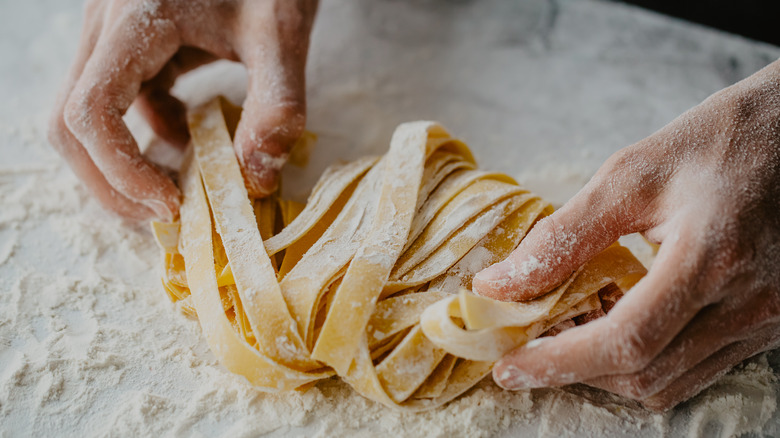Why Gordon Ramsay Always Has Additional Flour When Making Pasta Dough
The idea of making pasta from scratch may be an intimidating one, particularly since commercial pasta, when properly prepared, will always yield perfectly-textured meals while homemade pasta offers no such guarantees. But making homemade pasta isn't as difficult as it seems, say pro chef Gordon Ramsay, who we're guessing doesn't use factory-made pasta in his restaurants.
In a MasterClass devoted to making pasta dough, Ramsay offers up several tips for perfect pasta, from ensuring that you knead your pasta dough on a cold surface to keeping your pasta machine (if you have one) away from water and prepping so you have extra flour within arm's length. This means if your recipe calls for two cups of flour — as Ramsay's does — you'll probably want to make sure you have a bit more. Ramsay says having more flour on hand than your recipe calls for shouldn't be considered wasteful, because when it is eventually amalgamated into the dough, that flour turns into an additional serving. He says, "To you, [a touch of pasta on your fingers] looks a mess; to me, that's a portion."
The extra flour doesn't go to waste
We know flour is one of two critical ingredients in pasta making — the other being a liquid like water or egg. But because homemade pasta is affected by different factors from the weather (if a day is damp or humid, you'll need more flour) to the size of your eggs (if you are using eggs), it is always better to have the extra flour on hand to soak up any extra moisture, which in turn ensures you'll end up with the perfect consistency.
To use the extra flour productively, Ramsay suggests lightly dusting all of the equipment you're using to make pasta, including the board, the pasta machine, and your hands (if you're kneading by hand); the flour will keep the pasta dough from sticking to everything. The dough is ready when it isn't too gummy, it can be formed into a ball, and it can be easily cut and rolled. Once the pasta is good to go, any unused flour doesn't have to be thrown out — it can be stored and added to your next batch of pasta.
Ramsay has just one more piece of advice when it comes to adding flour: Too little will leave your dough sticky, while too much will make the dough dry, so it's best to add a little at a time since flour can be added to the dough, but not taken away.

